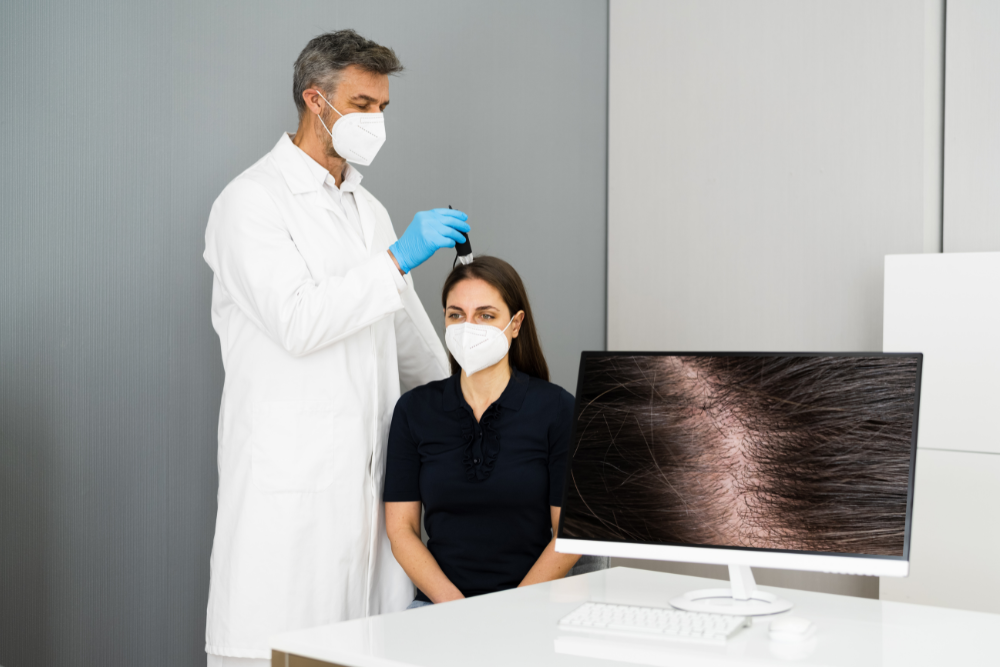
Understanding Hair Loss
Key Causes of Hair Loss:
- Genetics: The most common type, called androgenetic alopecia, is hereditary.
- Hormonal Changes: Pregnancy, menopause, and thyroid issues can trigger hair loss.
- Medical Conditions: Autoimmune diseases (like alopecia areata), scalp infections, and certain chronic conditions can contribute.
- Medications: Drugs for cancer, arthritis, depression, and heart conditions can result in hair loss.
- Lifestyle Factors: Poor diet, stress, and improper hair care may accelerate hair loss.
Symptoms of Hair Loss:
- Gradual Thinning: Often starting on the crown or along the hairline.
- Patchy Bald Spots: Circular or irregular patches of baldness.
- Sudden Hair Loss: Can occur due to shock, trauma, or illness.
- Full-Body Hair Loss: Resulting from medical treatments such as chemotherapy.
Comparison of Top Hair Loss Treatments
Below is a comparison of some of the most effective treatments available, focusing on their success rates, time to see results, and potential side effects.
| Treatment | Success Rate | Time to See Results | Common Side Effects | Approximate Cost (per month) |
|---|---|---|---|---|
| Minoxidil (Topical) | 60-70% | 3-6 months | Scalp irritation, redness | $30-$60 |
| Finasteride (Oral) | 65-75% | 3-6 months | Decreased libido, dizziness | $50-$100 |
| PRP Therapy | 55-70% | 3-4 sessions (6-12 months) | Mild swelling, tenderness | $400-$1,200 per session |
| Hair Transplant | 85-95% | 6-12 months | Swelling, scarring, recovery time | $4,000-$15,000 one-time cost |
| Laser Therapy | 40-60% | 4-6 months | Minimal, occasional scalp warmth | $100-$500 (device cost) |
Detailed Analysis of Hair Loss Treatments
1. Minoxidil (Topical Solution)
- Overview: Minoxidil, available over the counter as a foam or solution, is applied directly to the scalp. It works by increasing blood flow to hair follicles.
- Effectiveness: Approximately 60-70% of users experience moderate hair regrowth.
- Time to Results: Visible results usually appear after 3-6 months of consistent use.
Graph 1: Success Rate of Minoxidil
[Graph 1: Bar Chart showing the success rates]
Y-Axis: Success Rate (%)
X-Axis: Months
3 months: 30%
6 months: 60%
12 months: 70%
2. Finasteride (Oral Medication)
- Overview: Finasteride is a prescription medication for men that reduces the production of DHT (dihydrotestosterone), a hormone that shrinks hair follicles.
- Effectiveness: About 65-75% of men see a reduction in hair loss and some regrowth.
- Time to Results: Results become noticeable after 3-6 months of daily intake.
Graph 2: Finasteride Efficacy Over Time
[Graph 2: Line Graph showing efficacy over time]
Y-Axis: Percentage of Users Experiencing Results (%)
X-Axis: Months
3 months: 40%
6 months: 65%
12 months: 75%
3. Platelet-Rich Plasma (PRP) Therapy
- Overview: PRP therapy involves drawing the patient’s blood, concentrating the platelets, and injecting them into the scalp to stimulate hair growth.
- Effectiveness: PRP therapy is effective for 55-70% of individuals.
- Time to Results: Typically requires 3-4 sessions, with results visible after 6-12 months.
Graph 3: PRP Therapy Results
[Graph 3: Pie Chart showing PRP effectiveness]
- Effective for Mild Hair Loss: 30%
- Effective for Moderate Hair Loss: 40%
- No Significant Change: 30%
4. Hair Transplant Surgery
- Overview: This surgical procedure involves relocating hair follicles from a dense area to thinning or balding areas. Techniques include Follicular Unit Transplantation (FUT) and Follicular Unit Extraction (FUE).
- Effectiveness: About 85-95% satisfaction rate among patients.
- Time to Results: Results are permanent, but full growth is often visible after 6-12 months.
Graph 4: Hair Transplant Patient Satisfaction
[Graph 4: Bar Chart showing patient satisfaction]
Y-Axis: Percentage of Patients (%)
X-Axis: Time (months)
6 months: 70%
12 months: 90%
24 months: 95%
5. Laser Therapy
- Overview: Low-Level Laser Therapy (LLLT) uses laser devices to stimulate hair growth. It is a non-invasive option that can be done at home with laser combs or caps.
- Effectiveness: Suitable for those with early-stage hair thinning, with 40-60% of users seeing improvement.
- Time to Results: Consistent use over 4-6 months is required for optimal results.
Graph 5: Laser Therapy Usage & Results
[Graph 5: Area Chart showing cumulative improvement]
Y-Axis: Improvement in Hair Density (%)
X-Axis: Months
3 months: 25%
6 months: 40%
12 months: 60%
Lifestyle Tips for Managing Hair Loss
In addition to the treatments mentioned above, lifestyle changes can also play a vital role in managing hair loss. Here are a few tips:
- Healthy Diet: A diet rich in iron, biotin, zinc, and vitamins like D and E can support hair health. Include leafy greens, eggs, nuts, and lean meats.
- Stress Management: Chronic stress can lead to hair loss. Practices like yoga, meditation, and regular exercise can help.
- Scalp Care: Use mild shampoos, avoid excessive heat styling, and consider regular scalp massages to improve blood flow.
Conclusion: Finding the Right Hair Loss Solution
Hair loss treatments for men and women range from topical solutions and oral medications to advanced procedures like hair transplants and PRP therapy. The choice of treatment depends on the cause and severity of hair loss, personal preferences, and budget. Consulting with a dermatologist or hair restoration specialist can help determine the most suitable approach for you.
By taking the time to understand your hair loss and exploring the various options, you can find a solution that fits your needs and regain your confidence.






